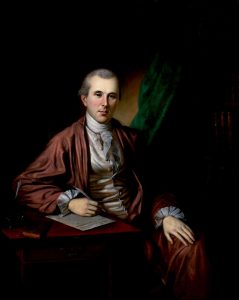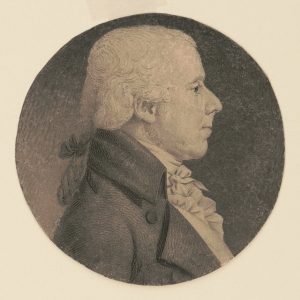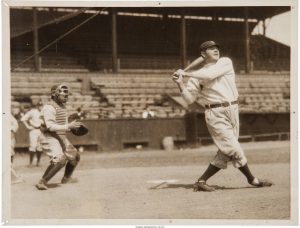It was like any other day for Benjamin Rush. The weather was warm and dry in mid-July 1793 in Philadelphia. Perhaps he had just seen a patient, or perhaps he was on his way to see one. Rush, a doctor, was being requested to treat patients left and right in the city, for Mumps, which was in its last cases, and Scarlatina Anginosa was taking over the city at this point in time.1 Suddenly, on the 25th of August, in this dry and warm weather, the clouds hid the sun in their cotton-like fluff and let their tears flow over the city. A day that would be a nice memory to many now seemed like a bad omen for what was to come.2 The days flew by and it was still warm and dry, August 1793. While the Mumps and Scarlatina Anginosa cases were settling down, something more had begun. Rush was suddenly being requested by not only patients but also by fellow doctors; by letter or in person, many were reaching out to Rush in hopes that he could help them. Many had contracted a fever that was not like any other. While Rush had only seen a couple of patients with this sudden fever, he knew that it was more than just that. He noticed the yellow skin and eyes of his patients. Many would have a tense pulse, also complaining of fevers, vomiting, and headaches. Rush would use the usual treatments that were very common at the time, purging and bloodletting. The few people who Rush treated seemed to get better with his treatments, but many would die at the hands of the bilious fever even when they seemed to get better. As Rush was being requested more and more, he realized that something was wrong in the city, which was frightening not just to him but to many others.3

As more people slowly became sick, perhaps many noticed what Rush had. Other doctors perhaps reached out to Rush to talk about the different and similar symptoms that their patients were experiencing. Headaches, eye pain, vomiting, stomach pains, chest pains, fevers, and the unmistakably yellow eyes and skin. However, as many noticed the bilious fever slowly spreading through the city, they also questioned how and why this was happening. It all came down to something that many didn’t expect. By word of mouth, Rush found that the cause for such malicious fever was putrified coffee, according to the words that were going from the most affected neighborhood to the citizens that lived close by. This fever all came down to some simple coffee beans that were thrown onto a dock on July 24th. Some damaged coffee beans were slowly rotting and releasing their toxins into the air thus giving the poor citizens who lived near the river this terrible fever.4 After hearing of such information and the conclusion of many, Rush connected all the dots, from his first patient to the most recent one, all were connected in one way. All are exposed to the coffee toxins in one way or another. This led Rush to give such illness its very name, Yellow Fever. Rush had once experienced this yellow fever before, in August of 1762, after a hot summer just like this one. It was an epidemic that spread from door to door, in the same manner as this one.5
Rush requested that his wife stay away with her aunt. For even if the fever was yet to touch other parts of the city, he wanted her to stay away.6 Rush, being a doctor who cared not just for his patients but for the entirety of the city, went out and spoke to as many of the citizens as he could. He spoke of the illness or fever as slowly spreading, a fever that was truly some type of evil. Many of the other doctors who had not yet treated such illness, were in denial. They refused to believe the word of Rush.7 However, this would soon all change. Soon, a newspaper was released, with all the recommendations to the citizens of the city, with the idea of how to prevent the further spread of the fever.8 The fever knocked from door to door, leaving its malicious shadow, hunting not only every home and alley but the whole city together. The article released by the College of Physicians was like a wake-up call to the citizens of the city, who, after not believing the idea of a hostile illness, were now fleeing the city in the hope of getting away from the fever. Just as the citizens were leaving, there were a couple of doctors who did too.9 This left Rush and the few doctors who were brave enough to stay, to open the doors of their homes to the sick. The heroes of the people who couldn’t leave because of the fever. Rush, knowing that staying was his duty as a doctor, didn’t give up on his patients.
As the fever spread more, Rush’s patients increased. Whether it was children or adults, age did not matter, for the fever left no soul untouched. The more people he treated, the more he noticed the symptoms of the malicious fever. Many patients would begin with a simple pain on their side, and it would all slowly change to things like poor vision, hot stomach, sore throats, sweaty hands, and in some cases bleeding from places like the ears, eyes, nose, and gums. There were different stages of how the fever would affect the patients, depending on what they were feeling at the moment of treatment.
The fever continued its torture over the city, as Rush noticed what treatments were not helping fight the fever, from smelling things like vinger and falts, which did not help stop the spread, fo the intake of bark and wine, which not only did not help but sometimes made the patient feel worse. Rush even tried aromatics and brandy. He also performed treatments like blistering, which was when heat was put on different areas where there was pain. The intense heat would cause blisters that would then be opened by rubbing with cloths drenched in turpentine or with bare hands. This did not do anything to help with the fever, just as the use of mercurial ointment did not do anything either.10 Soon after finding a manuscript in his library that Benjamin Franklin had given him, he started a new method for treatment. Rush used the main two treatments that he had used for many other illnesses before, purging and bloodletting. Bloodletting is when a small cut is made with a lancet or a knife to the elbow or forearm, where the median cubital vein is. Purging is when different types of substances or medicines are used to cause the emptying of the bowels.11 A couple of doctors had been questioning the treatments that Rush was conducting on patients since he had begun aggressive treatments. Rush began to treat patients more with purging, using calomel and jalap to empty the bowels of his patients, giving big doses of both, like ten grains of calomel and fifteen of the jalap. This caused a big change in some of his patients, which he even considered to be cured of the fever, thus causing the beginning of mercurial purging.12 While this was not the only method of treatment that Rush was using, it was one that the public and other doctors were very thankful for, since Rush made it known as a cure for the fever. However, as thankful as they were, they began judging Rush. Did he know what he was doing? Why were his methods not working on other doctor’s patients? This caused a sudden uproar with a couple of doctors who were still treating patients in the city. The demand on what methods were used by Rush was in the air, breathing down Rush’s neck, while he, in his moment of victory, was joyous in the change that he was creating among the victims of the fever.13

Rush came up with new routines of treatment, incorporating not only purging but different doses of bloodletting, all depending on how the patient’s pulse and appearance were during treatment. He even went as far as to draw twenty ounces of blood, which could end up accumulating from seventy to eighty ounces in a couple of days.14 Other doctors came up with their own methods of treatment and had their own idea of the origins of the fever. They too made them public just as Rush had. This caused controversy since many different people couldn’t and wouldn’t agree with some of the ways that others were treating patients. This caused Rush to speak up on what he was against and also explain his own methods.15 This led others to also speak up on why they disagreed with Rush, either questioning whether his treatments were safe for patients or refusing to believe that the fever was real.16 Rush, trying to get the citizens to understand his ways of treatment, and to make the people questioning him see his way, expressed how he had years of research from different epidemics that were just like the yellow fever, and how all his research led him to pick his ways of treatments.17 Few reached out to Rush, explaining how they agreed with his methods, and even giving him details on their own cases, where they used the treatments that worked successfully in treating their own patients.18 Those who disagreed reached out to the public by publishing articles, expressing that many doctors followed Rush’s treatment methods and found them successful, giving up on the debate and agreeing with him. These gave the citizens peace of mind.19 As poetic as the life of a doctor is, he is a soldier at war, in battle with an invisible enemy. What is to happen when the doctor ends up as a fallen soldier in the war? Who will call the medics?
As time passed by, days became a blur, never changing, treating patients morning, noon, and night. Days were usually always like this for Rush. The only difference was the couple of minutes he could sit down and write to his wife, telling her of different miracles that were happening.20 Rush’s home had now become a place open to those patients who did not have a home of their own to be treated in. However, as the heroic and good doctor that Rush was, many things can happen during the many moments of goodness that someone gives. Rush, like many others, had fallen at the hands of the malicious fever. His skin and eyes were a yellow color, and night sweats were the beginning of his illness.21 Through his sickness with the fever, Rush would continue to treat patients. He tried to do all the things that he and many believed would cause the fever to go down. He treated himself with his own treatments, purging and drawing ten ounces of blood from himself each day, and immediately going back to treating patients.22 He believed that he was truly cured. He received letters from many, not just his wife, but from important people and from other doctors.23 During his sickness, he had to refuse many. This caused him a lot of distress. He had a fear that his patients would not make it because he was not there himself, treating them.24 At the same time as this was happening, many of his pupils, and even his own sister, also fell ill with the fever. With this all happening, Rush still wanted to do all he could. He would respond to all the letters he received and he would fix the medication to be given to the other patients. Rush began to struggle with his disease; moving around became painful; he had no appetite; he continued to sweat at night and had trouble sleeping. Through all of this, he also had trouble coping with the constant death around him, including the death of his sister and pupils. While his ways of treatment were working and helping many patients, there was still great loss happening. Rush was having a hard time with this and he would even cry alone in his room away from the public eye.25 He questioned whether he was doing the right thing and whether there was more that he could do. The public couldn’t help but also question whether the methods he used were helping at all.
After seeing patients or when he was feeling unwell, Rush would take a small sip of wine. He would keep this small sip in his mouth for half a minute or as long as he could. This would refresh him and give him strength.26 He would also have a certain diet that he would follow during his time of sickness. Through all of this, Rush still believed in his ways and never gave up on the treatments or on helping as many as he could. He had received letters from close friends, who were imploring him to leave the city for his safty and health. Rush would reject the idea. He was not going to leave his patients or the important position that he was now standing on in the city.27 He knew what his responsibilities were, and he was not going to stop doing what he knew best. Like a soldier, he was going to stay and fight for his cause. In the end, Rush became more ill and believed that his life was going to come to an end. Despite this idea, Rush made it. He was still sick with the fever, but he was somewhat better.
The citizens of the city saw Rush as a hero. Not only was he saving so many lives, but he had opened the doors of his own home to the poor who were sick. October came beautifully and suddenly. This day was like a sudden miracle coming down on them, in beautiful droplets of rain. The weather that had been warm for so long, was suddenly interrupted by a wave of rain that carried with it a cold wind. This was like a blessing to Rush.28 For he, with all his research, knew that the cold weather meant the end of the yellow fever. Besides the fact the cases were still happening during the colder days and months, there was a decline in new cases of the yellow fever, and with it, the city was coming back to life. Rush could not wait to be reunited with his beloved children and wife. The city and even New York saw Rush in a whole new light; they saw him as a hero who was brave and committed to his patients.29 His methods had seemed to truly work and save so many.

Many respected Rush for all he did for the city of Philadelphia. However, many still criticized him for his belief in the origin of the fever.30 There was a belief that the fever was imported by a ship that came to Philadephia. Was this the case? No one actually knew. Rush resigned from the College of Physicians, and wrote his own book with his accounts of what happened during the yellow fever epidemic and of his methods.31 Today, Rush is a well-known figure when it comes to the topic of the Yellow Fever. While many didn’t see his methods as good, he did everything he could for his patients, and he saved many lives. The cause of the fever was not what Rush thought it to be, but he was still a hero for his bravery during the fever, and for his understanding of what had to be done. He made changes to the world today, even if they were small, reminding everyone of how important preventive measures are for any type of illness.
- Benjamin Rush, An Account of the Bilious Remitting Yellow Fever, as It Appeared in the City of Philadelphia, in the Year 1793 (Philadelphia: Thomas Dobson, 1794), 4-5. ↵
- Benjamin Rush, An Account of the Bilious Remitting Yellow Fever, as It Appeared in the City of Philadelphia, in the Year 1793 (Philadelphia: Thomas Dobson, 1794), 7. ↵
- Benjamin Rush, An Account of the Bilious Remitting Yellow Fever, as It Appeared in the City of Philadelphia, in the Year 1793 (Philadelphia: Thomas Dobson, 1794), 8-11. ↵
- Benjamin Rush, An Account of the Bilious Remitting Yellow Fever, as It Appeared in the City of Philadelphia, in the Year 1793 (Philadelphia: Thomas Dobson, 1794), 11-12. ↵
- Benjamin Rush, An Account of the Bilious Remitting Yellow Fever, as It Appeared in the City of Philadelphia, in the Year 1793 (Philadelphia: Thomas Dobson, 1794),13. ↵
- Letters of Benjamin Rush: Volume II: 1793-1813, vol. 5596 (Princeton: Princeton University Press, 1951), 637. ↵
- J. H. Powell, Bring Out Your Dead: The Great Plague of Yellow Fever in Philadelphia in 1793, Studies in Health, Illness, and Caregiving (Philadelphia: University of Pennsylvania Press, 1993), 12. ↵
- Benjamin Rush, An Account of the Bilious Remitting Yellow Fever, as It Appeared in the City of Philadelphia, in the Year 1793 (Philadelphia: Thomas Dobson, 1794), 21-24. ↵
- Stephen Fried, Rush: Revolution, Madness, and the Visionary Doctor Who Became a Founding Father, 1st ed. (New York: Crown, 2018), 350. ↵
- Benjamin Rush, An Account of the Bilious Remitting Yellow Fever, as It Appeared in the City of Philadelphia, in the Year 1793 (Philadelphia: Thomas Dobson, 1794), 193-194. ↵
- Carl Alfred Lanning Binger, Revolutionary Doctor: Benjamin Rush, 1746-1813 (New York: Norton, 1966), 213. ↵
- Benjamin Rush, An Account of the Bilious Remitting Yellow Fever, as It Appeared in the City of Philadelphia, in the Year 1793 (Philadelphia: Thomas Dobson, 1794), 201-202. ↵
- Benjamin Rush, An Account of the Bilious Remitting Yellow Fever, as It Appeared in the City of Philadelphia, in the Year 1793 (Philadelphia: Thomas Dobson, 1794), 202-204. ↵
- Benjamin Rush, An Account of the Bilious Remitting Yellow Fever, as It Appeared in the City of Philadelphia, in the Year 1793 (Philadelphia: Thomas Dobson, 1794), 271-272. ↵
- Benjamin Rush, An Account of the Bilious Remitting Yellow Fever, as It Appeared in the City of Philadelphia, in the Year 1793 (Philadelphia: Thomas Dobson, 1794), 223-225. ↵
- J. H. Powell, Bring Out Your Dead: The Great Plague of Yellow Fever in Philadelphia in 1793, Studies in Health, Illness, and Caregiving (Philadelphia: University of Pennsylvania Press, 1993), 82-84. ↵
- Benjamin Rush, An Account of the Bilious Remitting Yellow Fever, as It Appeared in the City of Philadelphia, in the Year 1793 (Philadelphia: Thomas Dobson, 1794), 234-235. ↵
- Benjamin Rush, An Account of the Bilious Remitting Yellow Fever, as It Appeared in the City of Philadelphia, in the Year 1793 (Philadelphia: Thomas Dobson, 1794), 236-237. ↵
- Benjamin Rush, An Account of the Bilious Remitting Yellow Fever, as It Appeared in the City of Philadelphia, in the Year 1793 (Philadelphia: Thomas Dobson, 1794), 241-242. ↵
- Letters of Benjamin Rush: Volume II: 1793-1813, vol. 5596 (Princeton: Princeton University Press, 1951), 662-663. ↵
- Benjamin Rush, An Account of the Bilious Remitting Yellow Fever, as It Appeared in the City of Philadelphia, in the Year 1793 (Philadelphia: Thomas Dobson, 1794), 341. ↵
- Benjamin Rush, An Account of the Bilious Remitting Yellow Fever, as It Appeared in the City of Philadelphia, in the Year 1793 (Philadelphia: Thomas Dobson, 1794), 343. ↵
- Benjamin Rush, An Account of the Bilious Remitting Yellow Fever, as It Appeared in the City of Philadelphia, in the Year 1793 (Philadelphia: Thomas Dobson, 1794), 345. ↵
- Benjamin Rush, An Account of the Bilious Remitting Yellow Fever, as It Appeared in the City of Philadelphia, in the Year 1793 (Philadelphia: Thomas Dobson, 1794), 346. ↵
- Benjamin Rush, An Account of the Bilious Remitting Yellow Fever, as It Appeared in the City of Philadelphia, in the Year 1793 (Philadelphia: Thomas Dobson, 1794), 349-350. ↵
- Benjamin Rush, An Account of the Bilious Remitting Yellow Fever, as It Appeared in the City of Philadelphia, in the Year 1793 (Philadelphia: Thomas Dobson, 1794), 352. ↵
- Benjamin Rush, An Account of the Bilious Remitting Yellow Fever, as It Appeared in the City of Philadelphia, in the Year 1793 (Philadelphia: Thomas Dobson, 1794),360. ↵
- Benjamin Rush, An Account of the Bilious Remitting Yellow Fever, as It Appeared in the City of Philadelphia, in the Year 1793 (Philadelphia: Thomas Dobson, 1794), 264-265. ↵
- Stephen Fried, Rush: Revolution, Madness, and the Visionary Doctor Who Became a Founding Father, 1st ed. (New York: Crown, 2018),365. ↵
- Stephen Fried, Rush: Revolution, Madness, and the Visionary Doctor Who Became a Founding Father, 1st ed. (New York: Crown, 2018), 272. ↵
- Stephen Fried, Rush: Revolution, Madness, and the Visionary Doctor Who Became a Founding Father, 1st ed. (New York: Crown, 2018), 277. ↵



1 comment
Natalia De la garza
Thank you for your incredible work I loved it! The vivid storytelling and historical detail you included about Benjamin Rush and the events of 1793 were so engaging and well crafted. It’s clear you’ve put a lot of thought and effort into this piece, and it really brought the past to life. Great job!